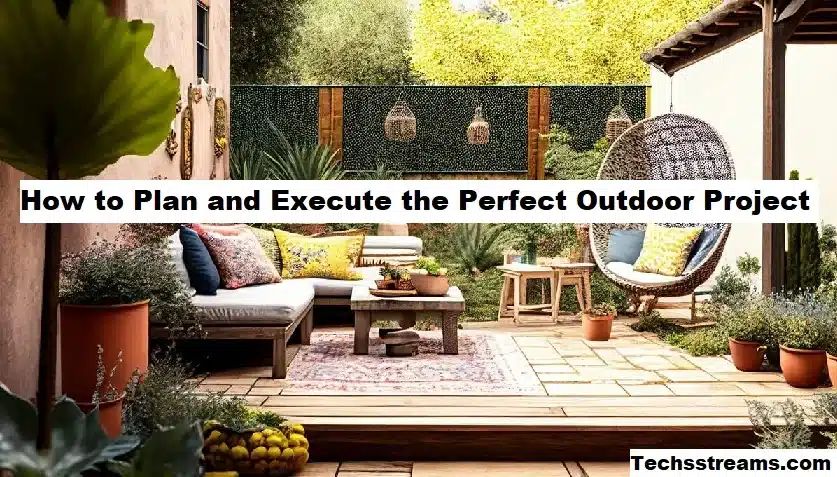
Dreaming of transforming your backyard into a haven for relaxation and entertainment? Outdoor project are a fantastic way to enhance your living space, boost your home’s value, and create a personalized retreat. Whether you want a cozy corner to unwind after a long day or a vibrant space for hosting gatherings, planning and executing an outdoor project can be a fulfilling endeavor.
Planning your Outdoor Project
First things first, ask yourself what you want to achieve with your outdoor project. Are you looking to create a serene garden, a dynamic play area for kids, or a stylish spot for alfresco dining? Defining your goals will guide every decision you make along the way.
Before diving in, gather inspiration from magazines, online platforms like Pinterest, and outdoor design blogs. Create a mood board to visualize your ideas and refine your vision. A realistic budget is crucial. List all potential expenses, including materials, labor, and any permits required. It’s always wise to add a little extra for unexpected costs.
Choosing the Right Materials
Choosing the right materials can make or break your project. Consider durability, maintenance, and aesthetics. Opt for eco-friendly materials like reclaimed wood or recycled composites to minimize your environmental impact.
Cost vs. Quality
Balancing cost and quality is key. High-quality materials may be pricier upfront but can save money on repairs and replacements in the long run. Sketch a layout of your space. Include all the elements you envision, such as seating areas, pathways, and garden beds.
Incorporating Greenery
Plants bring life to any outdoor project. Choose a mix of perennials, shrubs, and trees that suit your climate and soil type. Select furniture that complements your style and withstands the elements. Don’t forget cozy touches like cushions and outdoor rugs.
Preparation and Groundwork
Evaluate your site for soil type, sunlight, and drainage. These factors will influence your design and plant choices. Prepare your site by clearing debris and leveling the ground. This step is crucial for structures like decks and patios.
Ensuring Proper Drainage
Good drainage prevents water logging and soil erosion. Incorporate solutions like French drains or grading to direct water away from structures.
Building Structures and Features
Decks and patios extend your living outdoor project. Choose materials like composite decking or natural stone for durability. These structures add shade and style. Customize with climbing plants or lights for added ambiance.
Create a focal point with an outdoor project kitchen or fire pit. These features enhance functionality and provide a cozy gathering spot.
Landscaping and Planting
Choose plants that thrive in your local climate. Native species are often low-maintenance and beneficial for local wildlife. Healthy soil is the foundation of a vibrant garden. Test your soil and amend it with compost or other organic matter.
Mulching and Watering Techniques
Mulch helps retain moisture and suppress weeds. Install an efficient irrigation system to ensure your plants get the right amount of water.
Mix and match lighting types—string lights, lanterns, and spotlights—to create a magical atmosphere.
Placement and Installation
Strategically place lights to highlight pathways, seating areas, and focal points. Ensure all electrical installations are safe and weatherproof.
Opt for LED lights or solar-powered options to save energy and reduce your carbon footprint.
Outdoor Entertainment Areas
Add hammocks, lounge chairs, or even a water feature to create a peaceful retreat.
Designing a Dining Area
A well-designed dining area with a sturdy table, comfortable chairs, and shade options makes outdoor meals a delight.
Include a swing set, sandbox, or sports equipment to keep kids entertained.
Routine tasks like weeding, pruning, and cleaning furniture keep your space looking fresh.
Seasonal Care Tips
Adjust your care routine for each season. For example, protect delicate plants in winter and boost watering in summer. Natural pest control methods, like introducing beneficial insects or using organic sprays, help keep your garden healthy.
Safety Considerations
Install gates, cover sharp edges, and choose non-toxic plants to create a safe environment for children. If you have a fire pit or grill, keep a fire extinguisher nearby and clear the area of flammable materials. Protect your space from the elements with weatherproof furniture covers, shade sails, and windbreaks.
DIY can be cost-effective and rewarding but requires time and skill. Evaluate your abilities honestly. Complex projects, like electrical work or large constructions, often require professional expertise.
Research contractors, check reviews, and get multiple quotes to find a reliable professional.
Use trellises, wall-mounted planters, and hanging baskets to add greenery without taking up ground space. Choose furniture that serves multiple purposes, like a bench with storage or a table that converts to a planter. Optimize your layout with foldable furniture and built-in seating to make the most of limited space.
Incorporating Technology
Smart lights, weather stations, and security cameras enhance convenience and safety.
Set up timers and sensors to ensure your garden is watered efficiently, even when you’re not home. Install weather-resistant speakers and screens for outdoor entertainment.
Conclusion
Transforming your outdoor project space into a functional, beautiful retreat is a rewarding endeavor that adds value to your home and quality to your life. With careful planning, the right materials, and a bit of creativity, you can create an outdoor oasis that reflects your style and meets your needs.